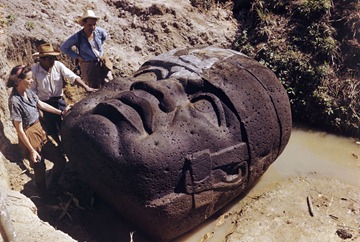Considered the “mother culture” of Mesoamerica and recognized as America’s oldest civilization, the people known today as the Olmec developed an iconic and sophisticated artistic style as early as the second millennium BC.
 The Olmec are best known for the creation of colossal heads carved from giant boulders that have fascinated the public and archaeologists alike since they were discovered in the mid-19th century. The monumental heads remain among ancient America’s most awe-inspiring and beautiful masterpieces today.
The Olmec are best known for the creation of colossal heads carved from giant boulders that have fascinated the public and archaeologists alike since they were discovered in the mid-19th century. The monumental heads remain among ancient America’s most awe-inspiring and beautiful masterpieces today.
Olmec: Colossal Masterworks of Ancient Mexico, featuring over 100 objects drawn primarily from Mexican national collections with additional loans from over twenty-five museums, is presented at the de Young Museum February 19 to May 8, 2011. Included in the exhibition are colossal heads, a large-scale throne, and monumental stelae in addition to precious small-scale vessels, figures, adornments and masks.
Olmec brings together for the first time new finds and monuments that have never been seen by American audiences and reveals new scholarship on Olmec culture and artifacts. Curator Kathleen Berrin explains, “In the fifteen years since the last Olmec exhibition on American soil, archaeologists have made amazing finds at key sites in Mexico. Informed by the most recent scholarship, this sweeping international project brings together a terrific collection of artworks that paint a vivid portrait of life in the Olmec heartland.”
The pre-Columbian Olmec civilization flourished in the Mexican states of Veracruz and Tabasco between 1400 and 400 BC, corresponding with the Golden Age of Greece and the Zhou Dynasty of China. Olmec architects and artists produced the earliest monumental stone structures and sculptures in North America, including enormous basalt portrait heads of their rulers weighing up to twenty-four tons. Examples of large-scale works in the exhibition include:
- Monument Q (colossal head) from Tres Zapotes––carved from a distinctive porphyritic basalt and weighing over eight tons, this was the second colossal head to be discovered at Tres Zapotes.
- Colossal Head 5 from San Lorenzo––discovered in 1946, it was created using a combination of polishing and fine and rough hammering.
- Stela 1 (female figure) from La Venta––standing over eight feet tall, the stela presents a surprisingly naturalistic female figure in a pleated skirt standing in a niche.
- Monuments 7–9 (twin figures and jaguar) from Loma del Zapote-El Azuzul––a sculptural representation of two young Olmec rulers, twins, paying homage to a feline-jaguar deity.
- Small-scale jadeite objects, which embody the symbolism of sacred and secular authority among the Olmec, attest to the long-distance exchange of rare resources that existed as early as 1000 BC, and Olmec artists were unsurpassed in their ability to work this extremely hard stone with elementary tools of chert, water and sand. Jadeite highlights on view include:
- Kunz Axe (votive axe) depicting a supernatural being whose physical features are drawn from multiple sources in the natural world.
- A massive selection of polished axes from El Manati made from serpentine, greenstone, and gray, green, black and veined stones.
- Offering 4 (group of sixteen standing figures and celts) from La Venta, an extraordinary discovery from 1955, is a multiple group of religious figures engaged in a major ceremonial scene.
- Majestic winged plaque with Maya hieroglyphic text on the verso dating to 100 BC.
Source: Art Daily [February 21, 2011]